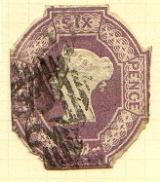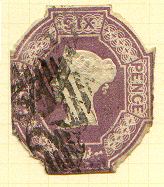
British embossed postage stamps
Encyclopedia
The adhesive embossed postage stamps of the United Kingdom, issued during the reign of Queen Victoria
between 1847 and 1854 exhibit four features which are unique to this issue:

1 Shilling (green) - 11 September 1847, 10d (brown) - 6 November 1848, 6d (mauve/lilac/purple) - 1 March 1854
The 1 shilling was the first British postage stamp to bear a value above 2d.
was engraved by William Wyon
using as his basis the City medal of 1837 which he had also engraved. (This was the same model used for the head engraved on the Penny Black
).
The original master die did not show the pendant curl at the back of the hair and was not used in this form on the postage stamps, although it was used at the Royal Mint
for coin
age.
From this master, a series of sub-dies were made and the curl added to the back of the hair. As such the curl differs on each value. Also added to the dies, after the outer design had been completed, was a die number. This takes the form of a number with the letters W W either before or after and appears at the base of the neck of Queen Victoria.
values, Dickinson silk thread paper was used. The threads are blue and are embedded into the paper at the time of manufacture.
The paper used for the six pence value was watermarked with the letters V R which were arranged so that it appeared complete on each impression.
The stamps were embossed, (printed), at Somerset House. Early collectors would often cut the stamps to shape retaining only the embossed central design and cut square examples are much more valuable.
Victoria of the United Kingdom
Victoria was the monarch of the United Kingdom of Great Britain and Ireland from 20 June 1837 until her death. From 1 May 1876, she used the additional title of Empress of India....
between 1847 and 1854 exhibit four features which are unique to this issue:

- The method of production of the dies used for the printing
- The use of silk threaded paper (on two of the values)
- The method of printing (one stamp at a time)
- The use of tinted gum (on the six pence value)
Issue dates
Three values of the octagonal stamps were introduced to cover higher foreign and registered postal charges on the following dates:1 Shilling (green) - 11 September 1847, 10d (brown) - 6 November 1848, 6d (mauve/lilac/purple) - 1 March 1854
The 1 shilling was the first British postage stamp to bear a value above 2d.
Embossing
The dies used for this type of printing have the embossed, (raised), portions of the stamp design cut away, (recessed), into the metal. The colourless detail as appears on the hair and diadem are achieved by variations in the depth of the engraving.The dies
The master dieDie (manufacturing)
A die is a specialized tool used in manufacturing industries to cut or shape material using a press. Like molds, dies are generally customized to the item they are used to create...
was engraved by William Wyon
William Wyon
William Wyon, RA , was official chief engraver at the Royal Mint from 1828 until his death. He was influenced by the master of relief sculpture, John Flaxman. Wyon was a highly visible proponent of the Neoclassicist vogue, and was elected to the Royal Academy in 1838.Wyon was born in Birmingham,...
using as his basis the City medal of 1837 which he had also engraved. (This was the same model used for the head engraved on the Penny Black
Penny Black
The Penny Black was the world's first adhesive postage stamp used in a public postal system. It was issued in Britain on 1 May 1840, for official use from 6 May of that year....
).
The original master die did not show the pendant curl at the back of the hair and was not used in this form on the postage stamps, although it was used at the Royal Mint
Royal Mint
The Royal Mint is the body permitted to manufacture, or mint, coins in the United Kingdom. The Mint originated over 1,100 years ago, but since 2009 it operates as Royal Mint Ltd, a company which has an exclusive contract with HM Treasury to supply all coinage for the UK...
for coin
Coin
A coin is a piece of hard material that is standardized in weight, is produced in large quantities in order to facilitate trade, and primarily can be used as a legal tender token for commerce in the designated country, region, or territory....
age.
From this master, a series of sub-dies were made and the curl added to the back of the hair. As such the curl differs on each value. Also added to the dies, after the outer design had been completed, was a die number. This takes the form of a number with the letters W W either before or after and appears at the base of the neck of Queen Victoria.
Paper
For the ten pence and one shillingShilling
The shilling is a unit of currency used in some current and former British Commonwealth countries. The word shilling comes from scilling, an accounting term that dates back to Anglo-Saxon times where it was deemed to be the value of a cow in Kent or a sheep elsewhere. The word is thought to derive...
values, Dickinson silk thread paper was used. The threads are blue and are embedded into the paper at the time of manufacture.
The paper used for the six pence value was watermarked with the letters V R which were arranged so that it appeared complete on each impression.
Tinted gum
Tinted gum was introduced on the six pence value following a printing which was made in error on the gummed side of the paper. Prior to the introduction of the tinted gum, it was colourless.Printing
The presses used for the embosses dies, allowed for only one stamp to be printed at a time. This method of production meant that the spacing on the sheets varied from wide spacing, (which is uncommon), to very narrow which is why examples with four margins are rare. In some cases the impressions were impressed overlapping each other by quite a large amount.The stamps were embossed, (printed), at Somerset House. Early collectors would often cut the stamps to shape retaining only the embossed central design and cut square examples are much more valuable.

